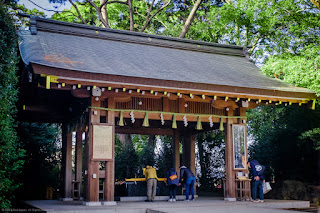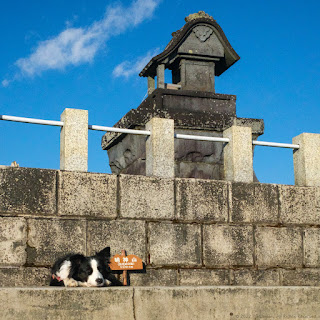Fujifilm X100V (23 mm) with 5% diffusion filter
ISO 3200 for 1/10 sec. at ƒ/11
Vilvia/Vivid film simulation
Purification Fountain before Visiting Shrine
Almost every Shinto Shrine has a “temizuya” (手水舎), which is a small roofed pavilion with a fountain of water where visitors wash their hands and rinse their mouths to purify oneself before entering the holy space of the shrine grounds.
At Samukawa Shrine, however, they use the reading of “temizusha” for 手水舎 instead of temizuya. This shot shows how large the pavilion is, which reflects the need to accommodate the nearly 2 million visitors to the shrine every year.
During my visit to Samukawa Shrine, I saw vehicle license plates from all over the Tokyo Metropolitan area including Saitama, Chiba, Kanagawa, and Shizuoka Prefectures! Clearly this shrine is well known far beyond the borders of the local farming and industrial community surrounding the shrine.
The shrine is in a class of its own in that it is one of the few major shrines in Japan that has been visited by a few members of the imperial family where they have planted commemorative trees during their visit.
Each tree is well looked after and placards are easily visible next to pathways where inscriptions state which member of the imperial family visited the shrine, when the tree was planted, and a short message from said family member.
Fujifilm X100V (23 mm) with 5% diffusion filter
ISO 3200 for 1/160 sec. at ƒ/11
Vilvia/Vivid film simulation
Shrine Gate with Paper Float Display
The main gate to Samukawa Shrine is named Shinmon Gate (神門). The gate itself is relatively new having been built in 1993. What I find impressive is how they were able to find craftsmen and artisans who still have the skill and knowledge to build such a structure that appears no different from similar gates dating back hundreds of years.
In this shot, we are able to enjoy the view of Geishun Nebuta—a large paper float inspired by the moving floats paraded at night in the streets of Aomori city during the summer Nebuta Festival.
Each year, Samukawa Shrine commissions the creation of a float by Nebuta masters in Aomori. Then in late December, the paper float is mounted to the upper portion of the gate and displayed for about 2 months to welcome visitors and the new year.
This year’s design expresses hopes for peace in an unstable world of wars, an end to the pandemic, bountiful harvests, successful pregnancy, and safe childbirth.
Fujifilm X100V (23 mm) with 5% diffusion filter
ISO 3200 for 1/200 sec. at ƒ/11
Astia/Soft film simulation
Stone Lion-Dog Statue
The komainu (狛犬) of Samukawa Shrine consists of the standard pair of lion-like dogs used to protect the shrine and shrine visitors by warding off evil
This shot is of the komainu on the right side of the shrine’s main gate, which was carved from stone and presented to the shrine in 1994.
Fujifilm X100V (23 mm) with 5% diffusion filter
ISO 3200 for 1/55 sec. at ƒ/11
Astia/Soft film simulation
Shrine on Clear Winter Day
In this shot, I tried to capture the beautiful architecture of the shrine from under the eaves of a covered wall surrounding the courtyard of Samukawa Shrine in the sleepy rural town of Samukawa, in Kanagawa Prefecture, Japan.
The main structure is this shot is the haiden (拝殿), or worship hall, which is where visitors approach to offer prayers or make a wish after tossing some coins as a monetary offering into the saisenbako (賽銭箱), or offertory box.
The courtyard of a shrine is called a keidai (境内), and the wall surrounding such a courtyard is called a tamagaki (玉垣).
At Samukawa Shrine, the tamagaki is roofed with lanterns hanging from the rafters, and extends completely around the courtyard making it very convenient to visit the shrine even on a rainy or snowy day.
From under the roof of the tamagaki, there is a ramp leading up to the front of the haiden making access very easy for the elderly, mothers with baby strollers, or visitors using wheelchairs.
It is not always easy for many structures built hundreds of years ago to implement barrier free access, but Samukawa Shrine has done a good job of making the shrine accessible to all, which I think is partially due to it being located on a large plot of flat land surrounded by suburban homes and farmland.
Back to the courtyard, if you look closely at the hanging lantern on the left, you can see a version of the chrysanthemum seal, which is almost identical to the crest used by the emperor and the imperial family. The symbol is also the national seal of Japan and is used on the front cover of Japanese passports.
Fujifilm X100V (23 mm) with 5% diffusion filter
ISO 160 for 1/70 sec. at ƒ/2.0
Provia/Standard film simulation
Shrine Main Hall Architecture
This unconventional shot aims to illustrate the beautiful architecture of Samukawa Shrine located in Kanagawa Prefecture, Japan.
By viewing the shrine at this angle, I hope to illustrate the use of metal fittings that are placed on the ends of rafters that extend out to the edge of the eaves and at the base of pillars.
Such fittings are often made of iron, copper, or gilt bronze, and are not only decorative, but also help to protect the ends of structural elements from weathering.
The earliest written records show that Samukawa Shrine was rebuilt in the year 727. The shrine structures predating the current shrine were rebuilt in 1927 after the Great Kanto Earthquake. The current structures were rebuilt in October 1997 using hinoki timbers (Hinoki cypress, Chamaecyparis obtusa) that were sourced from Mt. Ontake in Nagano Prefecture.
It is only natural for a shrine to be built from native trees, with hinoki being the number one choice for many temples and shrines for spiritual reasons in addition to structural and natural insect-repelling advantages of the wood.
Although Samukawa Shrine was becoming a bit worn and needed repairs, dismantling a shrine and rebuilding it with new timbers and fittings is not that uncommon regardless of the shrine’s condition.
With the fast pace of advances in technology, it is all too easy for centuries-old skills to become lost and forgotten. This process of rebuilding ensures that the skills and know-how of craftsmen and artisans in various fields of carpentry, sacred treasures, apparel, etc., will be passed on from generation to generation.
Fujifilm X100V (23 mm) with 5% diffusion filter
ISO 160 for 1/300 sec. at ƒ/2.8
Astia/Soft film simulation
Paper Fortune Wrapped on Straw Rope
A popular activity when visiting a shrine or a temple is to pick a random omikuji (御神籤/おみくじ), which is a small paper with a fortune written on it.
Should you acquire an unlucky fortune, you can either take it home with you and hope for the best while keeping a watchful eye out for whatever misfortune might befall you, or you can take the unlucky omikuji and tie it to a straw rope, metal rack, or the branches of a pine tree on the shrine grounds in hopes that the bad luck will remain with the omikuji and not follow you home.
In this shot, the omikuji likely had a bad fortune, and the bearer would rather leave the fortune behind at the shrine for proper disposal in hopes of minimizing their chances of succumbing to misfortune in their daily life.
If you look closely, you can see a karakusa pattern (唐草模様) on the omikuji. Although this pattern is often associated with burglars in modern Japanese culture, this auspicious pattern is originally based on the stems and leaves of intertwined vines, which represent vitality, prosperity, and longevity.
Fujifilm X100V (23 mm) with 5% diffusion filter
ISO 160 for 1/70 sec. at ƒ/2.2
Velvia/Vivid film simulation
Japanese Cypress Hinoki Torii Gate
There are three huge torii gates leading up to the Samukawa Shrine. The first one, Ichi-no-Torii, is 850 m from the shrine. The second one, Ni-no-Torii, is 240 m from the shrine. Finally the third one, San-no-Torii, is located at the entrance grounds of the Samukawa Shrine as shown in this shot.
Kamiike-bashi (Kamiike bridge) is made of stone and stands next to Kamiike pond to the right of the bridge. The bridge was rebuilt in 2022 due to decay.
The San-no-Torii was rebuilt with Japanese cypress (hinoki) in 1990 to celebrate the 2,650th anniversary of the accession of Emperor Jinmu, who is the legendary first emperor of Japan and founder of the imperial dynasty.
Copyright Notice for All Images:
© 2023 Pix4Japan. All rights reserved.
Unauthorized use for AI training is strictly prohibited.
Visit www.pix4japan.com for prints and licensed download options.











































